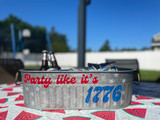Understanding the Different Types of Cut Vinyl: Calendered vs. Cast Vinyl – Oracal 651 vs. Oracal 751
Introduction:
Cut vinyl is a versatile and popular material used for a wide range of applications, from signage and decals to vehicle wraps and more. When it comes to selecting the right vinyl for your project, it's essential to understand the differences between calendered and cast vinyl. This blog post will explore the properties of these two types of vinyl, focusing on two popular brands: Oracal 651 (calendered) and Oracal 751 (cast). We'll also provide examples of various applications to help you choose the best vinyl for your needs.
- Calendered Vinyl – Oracal 651:
Calendered vinyl is made by extruding a heated mixture of PVC and plasticizers through a series of rollers, which flatten and stretch the material into a thin sheet. This process leads to a relatively thicker and more rigid vinyl compared to cast vinyl.
- Durability: Oracal 651 is known for its durability, typically lasting up to 6 years outdoors. However, it is more prone to shrinkage and may not perform as well under extreme temperature fluctuations or in highly curved surfaces.
- Cost: Calendered vinyl like Oracal 651 is generally more affordable than cast vinyl, making it a popular choice for short to medium-term applications.
- Applications: Oracal 651 is ideal for flat and simple curved surfaces, such as decals, labels, indoor and outdoor signs, window graphics, and lettering. Its high-gloss finish also makes it suitable for promotional materials and displays.
- Cast Vinyl – Oracal 751:
Cast vinyl is produced by casting a thin layer of liquid PVC onto a casting sheet, which is then processed through ovens to evaporate the solvents, leaving a solid vinyl film. This method results in a thinner and more flexible material compared to calendered vinyl.
- Durability: Oracal 751 is known for its superior durability, with an outdoor life expectancy of up to 8 years. It offers excellent resistance to shrinking, cracking, and peeling, making it ideal for long-term applications and harsh environmental conditions.
- Cost: Due to its manufacturing process, cast vinyl like Oracal 751 is generally more expensive than calendered vinyl. However, its superior performance characteristics often make it a worthwhile investment for certain projects.
- Applications: Oracal 751 is perfect for complex curved surfaces, vehicle wraps, fleet graphics, marine applications, and long-term outdoor signage. Its conformability and resistance to shrinking make it an excellent choice for surfaces with rivets, corrugations, or extreme contours.
Conclusion:
When choosing between calendered and cast vinyl, it's essential to consider the specific requirements of your project. Oracal 651 (calendered) is a cost-effective option for short to medium-term applications, while Oracal 751 (cast) offers superior performance for long-term projects and challenging surfaces. By understanding the properties and applications of these two types of vinyl, you can make an informed decision and achieve the best results for your project.
Recent Posts
-
Is your Heat Press Hot or Not?
When it comes to the quality of your finished products, maintaining accurate temperature control is
-
Unlock Your Creativity with Craft Vinyl Projects
If you're seeking an exciting and imaginative way to breathe new life into your living space, wardro



